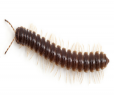
Problems with Millipedes are entirely controllable under professional care. Our treatment goal is to stop a problem at its source so it doesn’t keep coming back. Using state-of-the art equipment and methods, our licensed exterminators will inspect your home’s environment and construction to identify the problem and determine the best course of action. Contact us today!
Millipedes are similar to centipedes, but they have two pairs of legs per body segment. Most millipedes have very elongated cylindrical bodies and are generally black or brown, although there are a few brightly colored species. They will characteristically coil up when disturbed in a fashion similar to Sow or Pill Bugs. The name means “thousand foot” but in reality, common species have between 36 and 400 legs. They can easily be distinguished from centipedes which move rapidly, and have a single pair of legs for each body segment.
Millipedes are arthropods and range in size from 2 to 280 millimeters (1/16th inch to 11 inches) in length. They have two pairs of legs per segment (except for the first segment behind the head which does not have any appendages at all, and the next few which only have one pair of legs). Each segment that has two pairs of legs is a result of two single segments fused together as one.
Millipedes are usually restricted to moist places and they are herbivores, so they feed on organic matter such as decomposing vegetation. A few species are omnivorous or carnivorous, and may prey on insects and centipedes, or on earthworms. They are beneficial as “recyclers” of organic matter.
However, they become a pest when they migrate into buildings as accidental invaders. Millipedes are usually found in the garage, basement or lowest level although they may wander into other parts of the house. In the home, they usually die due to desiccation, still, in moist basements, they can survive longer.
Millipedes that wander indoors usually die in a short time because of the dryness, and spraying cracks, crevices and room edges is not very useful. Sweeping or vacuuming up the invaders and discarding them is the most practical option.They are harmless; they do not feed upon building structures or furnishings and they can not bite or sting and they can’t reproduce indoors.
Controls for millipedes are aimed at keeping millipedes outdoors or reducing their numbers at the source. Cracks, gaps and other points of entry around windows and doors and in foundation walls should be sealed if possible.
Removing organic matter such as plant mulch and dead leaves from against the house may help, and damp conditions around the house foundation should be corrected. Pesticides around the perimeter of the home will help reduce millipede numbers but won’t eliminate the problem.